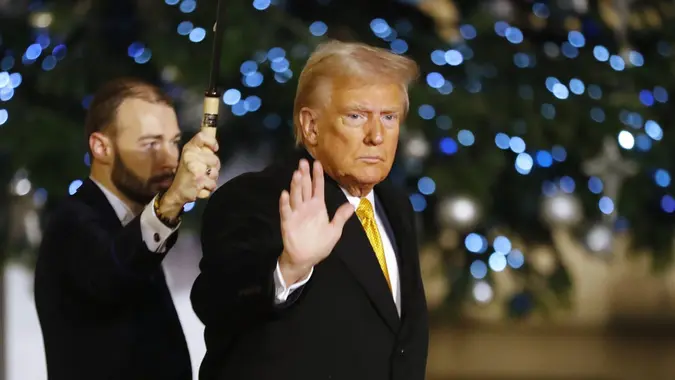6 Changes That Could Come to Upper-Class Retirees’ Finances in the First Month of Trump’s Presidency

Commitment to Our Readers
GOBankingRates' editorial team is committed to bringing you unbiased reviews and information. We use data-driven methodologies to evaluate financial products and services - our reviews and ratings are not influenced by advertisers. You can read more about our editorial guidelines and our products and services review methodology.

20 Years
Helping You Live Richer

Reviewed
by Experts

Trusted by
Millions of Readers
Just over a week after President Donald Trump regained the White House, signs of financial change for upper-class retirees are already emerging. Americans are stunned at Trump’s string of executive orders, and for wealthy retirees, those fast-moving policy changes can radically alter everything from tax burden to healthcare costs.
With Trump’s first week back in office officially in the books, it’s clear retirement planning strategies could need a heavy rework. In his first month as president, upper class retirees could face these six things happening to their finances.
Potential Tax Cuts
The Trump administration wants to renew the Tax Cuts and Jobs Act of 2017, which would benefit affluent retirees. House Speaker Mike Johnson announced that Republicans will finalize and adopt their tax plans in budget form by February’s end, despite lacking visible executive orders on tax policy, Politico reported.
“If the Tax Cuts and Jobs Act is allowed to sunset, taxes could increase for 62% of Americans,” said Ben Rizzuto, a wealth strategist at Janus Henderson Investors.
However, if it is renewed, upper class retirees could benefit. AP News reported that the top 0.1% of income earners would receive an average decrease of $314,000 if all tax programs are extended without changes. Not to forget that Trump had plans to eliminate the $10,000 annual limit on SALT tax deductions, which might also help rich retirees in high-tax states.
Social Security Benefit Changes
Trump wants to cancel federal taxes on Social Security earnings to provide greater spending power for retirees from wealthy backgrounds, according to CNN. Currently, 40% of people who receive Social Security benefits pay tax on these benefits.
According to a Tax Policy Center analysis, removing Social Security benefit taxes would lower Social Security and Medicare fund income by $1.5 trillion in the next ten years. Eliminating the Social Security benefits tax would decrease the available resources by one year faster than planned.
The analysis further indicated that the tax cut would mostly help U.S. workers earning between $63,000 to $200,000. Implementing this plan would need legal approval from Congress but may also exacerbate problems with keeping the system functional into the future.
Market Volatility
Financial markets reacted to the beginning of Trump’s second term: Treasury yields fell as stocks rose, relieved that Trump did not immediately impose broad tariffs. But when Trump mentioned discussing 25% tariffs on Canada and Mexico that would start on Feb. 1, uncertainty rose.
The market is reacting to new policies and executive orders, and the upper class retirees with massive investment portfolios should be ready for short-term volatility.
“More broadly, I think it’s important for investors to stay focused on the long-term,” said Rizzuto.
Healthcare Cost Adjustments
As soon as he was in office, Trump signed a sweeping order reversing multiple Biden-era healthcare policies. It included withdrawing rules that were intended to lower Medicare and Medicaid patients’ prescription drug costs and strengthen the Affordable Care Act.
But Trump’s actions didn’t have a measurable impact on things like the $35 monthly insulin limit or the $2,000 annual cap on prescription drug costs. Looking toward potential changes to Medicare Advantage plans and to drug price negotiations, upper class retirees should be watching, as these can impact their healthcare costs.
Retirement Account Regulations
Retirement account regulations have not yet been changed in the short term. But upper-class retirees should know that the administration could also seek to change withdrawal age requirements or limit contribution amounts in 401(k) plans and IRAs.
The IRS has set the contribution limits for 401(k) plans at $23,500 in 2025, up from $23,000 for 2024. The catch-up contribution limit for those aged 50 or older is $7,500, and for those aged 60 to 63, it is $11,250.
These changes also allow upper-class retirees to maximize their savings during their retirement. There, however, could be potential tax policy shifts and market environments forcing upper-class retirees to reconsider their retirement account strategies.
Potential Inflation Concerns
The tariffs Trump wants to impose could cause consumer prices to rise, including the buying power of upper-class retirees. Trump didn’t initiate tariffs on day one but gave himself until Feb. 1 to implement a 25% tariff on Canada and Mexico, The New York Times reported. According to Nomura, these may be rolled out gradually, starting in Q1 2025.
With these possible policies, the Federal Reserve has reconsidered its interest rate easing plans through 2025, while Treasury yields rose to a 14-month high.
Trump also signed executive orders declaring a national energy emergency and revoking electric vehicle regulations from the Biden administration. These actions and proposed tariffs could affect consumer prices and dent the purchasing power of retirees.
Editor’s note on political coverage: GOBankingRates is nonpartisan and strives to cover all aspects of the economy objectively and present balanced reports on politically focused finance stories. You can find more coverage of this topic on GOBankingRates.com.
 Written by
Written by  Edited by
Edited by 

























